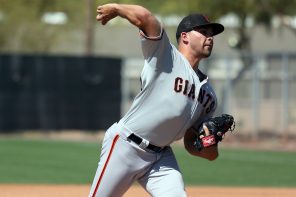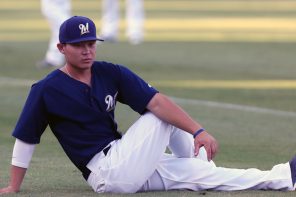Ronald Herrera
 |
|
Herrera’s August 3rd start vs. Hartford was a case study in the early-inning trouble he’s been having since the All-Star break. He struggled to locate his fastball in the first two innings, and at the same time had trouble gripping his breaking stuff, which led to flat offerings being left up in the zone and getting hit hard. He threw 44 pitches in those two innings, giving up 5H, 3R, 2 ER, with each of the 12 ABs ending with contact, and just five first-pitch strikes to the first 12 batters he faced. He did settle in the second time through the lineup after changing up his sequencing and starting some hitters with the changeup, and a few sliders with men on, which then set up a better-commanded fastball that found some movement. For the remaining 3.1 innings, with improved sequencing of his four-pitch mix for strikes keeping hitters off balance, he allowing just two more hits and no runs, with two walks and a strikeouts. His delivery was more fidgety than my past viewing, rocking to-and-from the plate at times while receiving his sign with glove at the waist, before toe-tapping a final time to gather, and then leading to a smooth delivery with a moderate leg lift leading to a hard push and solid extension of the rubber, and a quick arm action from a 3/4 slot. There is some drop-and-drive there, but it’s not a pronounced drop, and overall he is able to repeat his mechanics, though he will fall to the first base side at times when dialing up the velocity. Here’s some video of the motion from a separate visit I made to the park on 7/29. His fastball sat 89-to-93 (T94), and it showed solid two-seam boring action, using it inside and as an effective backdoor to righties. He also flashed a cut version with some sink that was located mostly down and in to lefties that sat in the lower end of the velo band. His changeup sat 82-to-84 mph and was the most effective pitch of the night, and he was able to spot it to the outer third with some arm-side fade to lefties and some tumble to both lefties and righties, and throwing in back-to-back at times. It’s indistinguishable out-of-hand vs. the fastball, which plays it up. His slider (83-to-86) had a flat, cutter shape early on, but by the third inning it was clearly separated from the cut version of the fastball, showing some sharper strike-to-ball sweep with some late bite when it was dialed in. He struggled with the curveball (77-to-81 mph) early, showing gradual break before developing a more typical 11-to-5 shape with average depth and some snap in the higher velo range as the game went on. Overall, Hererra’s bread-and-butter is commanding his four-pitch mix down in the lower third to get guys out. But his past month’s work shows a pattern of inconsistency in the early frames, with his last three losses looking like this – (6 hits, 5 ER in first two IP vs. Bowie 7/6 (38P); 3 ER, 4H in first two IP vs. Reading 7/14 (48P); 2H, 3R/2ER in 8/8 start vs. Richmond (no-decision), with first 13 ABs ending in contact (32P). That said, he’ll need to focus on mixing his pitches more aggressively early in the game vs. stubbornly trying to establish the fastball, as he did in this 8/3 viewing. And he’ll need to focus on first-pitch strikes and getting ahead in the count more consistently to be more effective (3.02 ERA working ahead, 5.87 when behind), especially early in games and against righties, who are hitting .293 against him (vs. lefties at .226) this season That said, he is a durable 21-year old with a solid four-pitch mix, and a regular turn in the Trenton rotation shows that the Yankees are confident in his development path at this point, though they would prefer to be seeing more consistency in the quality of his starts to finish the year on a high note. |



